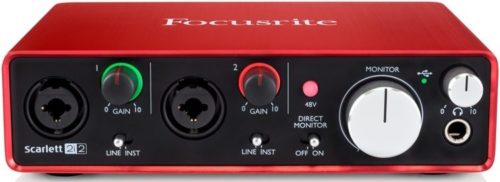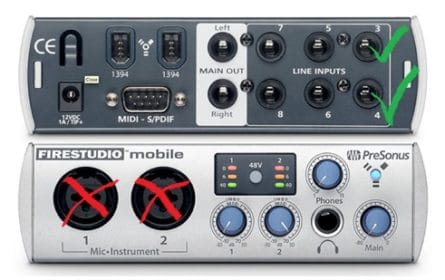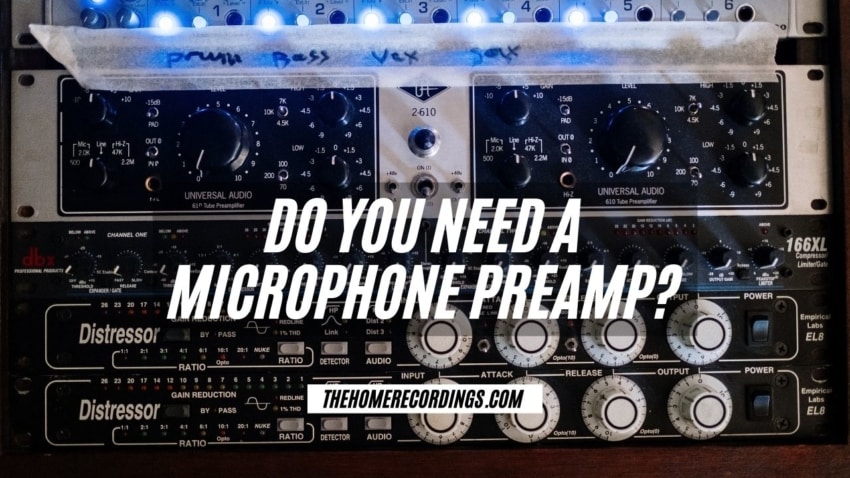Last updated on December 31st, 2023 at 06:03 pm
This is a question I asked myself a long time ago and I assume that many of you have the same question now.
So, I did a lot of research on the matter and I intend on sharing what I found out with you here!
In this post, I will explain exactly IF you need a preamp for your microphones, as well as give you a good idea of what a microphone preamp does, how much it costs, how to use it with your audio interface, etc.
Let’s get started!
Do you Need a Mic Preamp?
A preamp is designed to amplify low level signals to “line level”, which is the standard operating level of recording equipment. Since microphone signals are below this level, preamps are required to increase it to a point suitable for recording, usually around 30-60dB, or more.
Please note that Audio Interfaces come with built-in preamps as well and that it’s generally not worth buying an additional external preamp since those will be more than enough for most users.
Let’s take a quick look of what a Microphone preamp is and how it works:
What is a Microphone preamp?
A preamplifier is either the circuit within a device (Microphone/Audio Interface), or it can also be a dedicated external device that has the same circuit in it.
The objective of a preamp is to increase the level of the signal coming from the microphone, since they are usually too weak to be transmitted to a recording device with adequate quality.
The level of signal required by these recording devices is called line level.
So, you could say that a preamp increases the microphone signal level to line level by also providing stable gain and reducing noise, which could be harmful to the signal.
A mic preamp not only provides gain for the microphone’s signal, but it can also feed 48v phantom power to condenser microphones.
Essentially, condenser microphones require power to work, otherwise known as phantom power, and preamps can provide this over XLR cables.
External Preamps vs Audio Interface preamps
In essence, both do the exact same thing, which is to increase the signal level to line level.
While the preamps featured in most audio interfaces are enough for 99% of situations, especially if you’re not recording music professionally, there are some benefits to having dedicated external preamps:
Benefits of a dedicated external preamp
While there are many benefits to getting a dedicated preamp, please note that most people won’t be able to tell the difference in audio quality, and since they can be quite expensive, I wouldn’t recommend getting one unless you really need it.
Here are the Pros of an External Preamp;
- Increased Gain: The job of a preamp is to increase the signal level to line level, and some microphones, like the Shure SM7B, require a lot of gain to work properly, and most budget audio interfaces can’t handle this.
- Improved sound quality: The improvement in sound quality may not be as obvious at lower levels, but increasing the gain will provide a noticeable difference. This is because the circuitry of external/dedicated preamps is a lot more sophisticated, and they provide better headroom, less noise, etc.
- Lower noise: Most preamps, even in budget Audio Interfaces, are actually really quiet. But using a low output mic to record a quiet signal might introduce noise, which can be mitigated by a good preamp.
- Sound coloring: The preamps in most Audio Interfaces sound very clean and clear, and getting an external tube preamp, which are known for sounding warm, might help you achieve a different sound.
- Extra Mic Inputs: Using your mic with an external preamp will allow you to the connect it to the line inputs of the Audio Interface, essentially giving you more mic inputs.
Note: Use XLR cable on one end (or on both if your setup will allow it) and TRS on the other; these are balanced cables (Stereo).
Some features that external preamps offer in comparison to most Audio Interfaces are a Phase Reverse and Low cut filter (High Pass).
Preamps on an Audio Interface

Most Audio Interfaces, even the inexpensive ones, have the XLR inputs on the front, as well as other inputs on the back, like Line-in and Instrument inputs, and the Mic- and instrument inputs have preamps, while the line-in inputs don’t.
The preamps featured on most audio interfaces are designed to sound as neutral as possible, since you generally don’t want them coloring the sound in order to get the most accurate recording possible.
Let’s take a quick look at the different inputs and if they feature preamps or not:
Mic inputs
Usually on the front of the audio interface, the mic inputs come in combi- XLR/TRS format and have a preamp and a Gain Knob to help you adjust the Gain of the microphones connected to it.
Note: You can generally connect any balanced cable (XLR/TRS) or unbalanced cable (TS) to these inputs.
Line-In Inputs
The line-in inputs don’t require a preamp since they already are at line level.
They are used to connect a non-instrument piece of hardware, such as an external preamp, compressor, EQ, etc., or instruments that have a line output level, like Keyboards and synths.
Instrument Input
The instrument input has the most variable signal and does require a preamp to be raised to line level, and here you connect instruments such as electric Guitars and Basses.
Should you get a Dedicated preamp?
More often than not, the answer will be no.
The reason for this is that the preamps that come already built-in with most audio interfaces sound absolutely fantastic.
I record using an Audient iD14, which usually sells for less than $300, and the sound quality is phenomenal, plus it’s got enough gain to record even the Shure SM7B.
For 99% of users, an audio interface is more than enough.
Dedicated preamps do have their place, but I honestly believe that they mostly belong in high-end studios, especially since the most affordable ones start at $300.
If you are still considering purchasing one, then here are the different types of preamps that you could get:
Different types of Microphone preamps

There are lots of different kinds of preamps available on the market and each of them will fulfill certain needs and have specific features, such as coloring the sound.
The ones that add color generally are: Tube- and some Solid-State Preamps.
While the ones that fall under the “Transparent” category are: Digital and some Solid State Preamps.
Note: No preamp type is better than the other since it all comes down to your own preferences and needs.
Tube Preamps
These preamps use Valves, or Vacuum tubes, to create Gain, and these will color the sound significantly, usually making it sound “warmer”.
Tube Preamps are known for adding warmth especially to the mids, but also body to the bass and airiness to the highs.
The higher the signal, the warmer it sounds.
Additionally, tube preamps tend to naturally compress the sound as well.
Solid State Preamps
Transistors are great at creating gain with less heat, which means that as the gain increases they can maintain very low distortion until they reach the maximum level, at which point they will clip.
Up until that point, they usually sound very clean.
Digital Preamps
Digital preamps take the analog signal and convert it to a digital signal, adding their own sonic flavor in the processing before the signal is sent to the DAW.
These preamps are useful because they allow you to bypass the Audio Interface’s built-in audio conversion which tends to be inferior (although in most cases it’s certainly not a problem).
Technically you could refer to these as Audio Interfaces, since they amplify the signal and also convert it to a digital format so that your PC can record it. BUT their main focus is on the preamp!
These are all Microphone specific preamps, but there are also Instrument specific ones available that are designed to optimize the tone of a specific instrument, such as Bass Guitar, Electric Guitar, etc.
How much do Microphone Preamps cost?
Preamps have a huge range of prices, but there is a common theme among all of them; none of them are actually cheap.
If you want one that can give you a good performance, then you’re looking at least at a $300-dollar product, and they can easily reach the $2500 mark.
Some good and affordable options would be the ART Pro MPA II, which is a 2 channel Tube preamp.
Another cheaper option is the ART TPS II, which also is a 2 channel Tube Preamp.
But if you want the best dedicated preamps money can buy, then be ready to fork out close to $3000.
Who could benefit from a Microphone preamp?
If I’m completely honest here, the only reason you should get a microphone preamp, especially if you are building a budget home studio, is if you have a really low output microphone that your Audio Interface can’t possibly handle.
But in that case, you should consider returning the audio interface and getting one that offers more gain.
Microphones such as the the Heil PR40 and the Shure SM7B require a lot of gain to work properly, and here it might make sense to get a dedicated preamp.
Now, if you already purchased a preamp, you should know how to properly connect it to an Audio Interface to record properly:
How to Connect a Preamp to an Audio Interface?

When using an external preamp, you don’t want to send that signal into the preamp of you Audio Interface since it defeats the purpose of using a dedicated one in the first place.
So, what should you do instead?…
- Connect the microphone to the XLR Input on the external Preamp.
- Connect a cable either an XLR or TRS cable to the output of the Preamp.
- That same cable should be connected to the Line inputs on the Interface (usually on the back).
If you’re going to be doing this, then read this post on Balanced vs Unbalanced cables, since you should always use balanced ones to connect a preamp to an audio interface.
Microphone Preamp vs Audio Interface
If you read the entire post then you probably know the answer to this one, but since I got this question many times, I decided to include it;
A preamp is designed to increase the signal of a microphone to a level that is useful for recording, otherwise known as “line level”.
An Audio Interface also has preamps, usually of a lower quality, but it also converts the analog signal into a digital one to be recorded on your DAW.
In order to use a preamp you will need an audio interface to connect it to, at least in the vast majority of the cases, and to be honest, most preamps that come already built-in in most modern audio interfaces, sound fantastic.
Unless you have something like a Shure SM7B, where most audio interfaces can’t handle the low output level, I wouldn’t recommend getting an external preamp, at least not for the vast majority of people recording music from home.
Here’s a detailed article I wrote where you can learn the differences between an preamp and an audio interface in detail.
Conclusion
If you are just starting out, then forget about external preamps and actually invest a bit more in a powerful Audio Interface with decent preamps already built-in, like an Audient iD14 or an Apollo Twin MKII.
So, if you feel that you need something to improve your recording quality and budget is not much of an issue, buy one! They are worth it!
But again, I wouldn’t worry about investing in a preamp until it’s really necessary.
I hope this information helped! See you in the next one.
Audio Interfaces have built-in preamps, so you wont really NEED a preamp.
However, getting an external- and higher quality one should help you achieve an overall better signal and, therefore, a better sound as well.
Yes. Most dedicated preamps you can buy actually improve the signal.
However, it’s not as much of a difference as you would think since most audio interfaces on the market today actually feature some great-sounding preamps.
Mixers have built-in preamps, which means that you don’t really NEED an external preamp.
However, preamps can increase the quality of the audio, especially if the ones in your mixer are of a lower quality.
Audio Interfaces and Mixers already come with built-in preamps, so getting a dedicated one is not needed unless you need more gain than the audio interface, or mixer, can provide.
A Condenser microphone requires +48v of Phantom Power to work since the signal of the microphone on its own is too weak, which is why it needs a preamp to provide that power and to raise the signal to “line level”.

Confused…..u say…..
So, what should you do instead?…
Connect the microphone to the XLR Input on the external Preamp.
Connect a cable either an XLR or TRS cable to the output of the Preamp.
That same cable should be connected to the Line inputs on the Interface (usually on the back)….
Which INTERFACE is that, another EXTERNAL one or?
I am getting a low signal with a sm57 into a focusrite clarret usb for recording acoustic guitar why is this?I need to turn up the gain nearly full kind regards Stephen Fell
Good info for a beginner but I find it somewhat misleading. A mic pre can do wonders for a vocal recording, whether it’s in a pro setting or you’re recording in a home studio. Saying there’s not much of a difference isn’t accurate, depending on the gear in question of course.
Great, have been stack for a period about this. Thanks
Thanks – good read and very helpful.
This is super useful. Straight to the point and really well written. Just discovered your website. I hope that u are still creating content 🙂
cheers